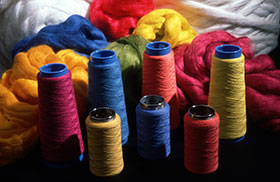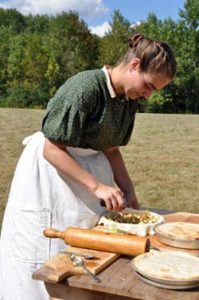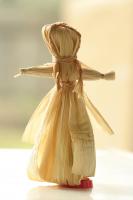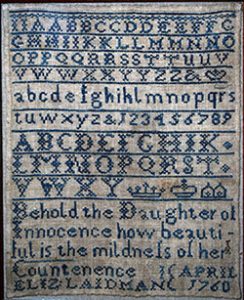Chances are if you are studying colonial times, your teacher will assign a hands-on project. You could make a model of the Jamestown Fort or a copy of the Declaration of Independence-but why not try a craft that the colonists themselves would have done?
Every colonial family except for the very rich had to be able to make their own soap, candles, furniture, cloth, baskets, toys, and musical instruments. Below is one practical craft to try. Scroll down and check our lists of books and Web sites for more ideas.
Dyeing Fabric
The natural color of cotton and most wool cloth is a pretty boring off-white. If colonists raised the sheep or grew the cotton to make the cloth, they probably wanted to dye it some other color so the dirt wouldn't show. Fancy fabrics could be store-bought by the well-to-do, but most people worked with what they had, and there were plenty of dyes to be found all around them.
 Crushed purple grapes or grape juice will make a purple dye. Yellow onion skins make a light orange color. Cherries or beets give a red or pinkish color. Carrot tops (the green, leafy part) will give a green color.
Crushed purple grapes or grape juice will make a purple dye. Yellow onion skins make a light orange color. Cherries or beets give a red or pinkish color. Carrot tops (the green, leafy part) will give a green color.
You can try dyeing unbleached muslin fabric (available at craft stores) for an experiment in colonial home crafts.
First, you will need to treat the fabric with a fixative so the color will last longer and stick to the fabric better. If you will be working with berry dyes, add ½ cup salt to 8 cups cold water. Then add the fabric and simmer for an hour.*
For dyes from plants, use 8 cups cold water and 2 parts vinegar. Again, add your fabric and simmer for an hour.*
*Ask for a grownup's help with the stove.
Add fabric to the fixative and simmer for an hour. Rinse the material and squeeze out excess liquid. Rinse in cool water until the water runs clear.
Time to Dye
Use an old pot for dyeing, and wear rubber gloves. Having purple hands can get really old by the second day.
Chop your plant materials carefully. You can ask your grownup to help you. Measure to see how much plant stuff you have. Put it in the pot and add twice that amount of water. Add the fabric and simmer (with a grownup's help) until you get the color you want. Remember, the fabric color will dry a bit lighter than what you see in the pot. If you want a very dark stain, just turn off the heat, move the pot somewhere secure (away from the dog!) and let it soak overnight.
Word of Warning! These fabrics can be very pretty, but they MUST be washed separately in cold water—unless you want to start a new trend with purple socks and underwear.
Want to try more colonial crafts? Check out these books from the library for other project ideas:
Felicity's Craft Book: A Look at Crafts from the Past with Projects You Can Do Today by Rebecca Sample Bernstein and Jodi Evert
This complementary book to an American Girls series has sixteen projects to try including cross-stitch and a tussie-mussie.
Food and Recipes of the Thirteen Colonies by George Erdosh.
Recipes for hasty pudding, flat jacks, Dutch walnut-cinnamon squares, Southern succotash, hoppin' John. Includes the history behind the dishes.
Great Colonial American Projects You Can Build Yourself by Kris Bordessa
This book brings the colonists' ways to life and includes many fun, hands-on projects.
Home Crafts by Bobbie Kalman
"…a step-by-step account explaining how the settlers made candles and soap, carded and spun wool, dyed cloth and sewed samples. …students will discover domestic home crafts through bright color photographs and simple, clear text."
Pioneer Crafts by Barbara Greenwood
"With this book in the Kids Can Do It series, kids today can dye fabric, weave gift baskets or turn a piece of felt into a pair of cozy moccasins, and make crafts the pioneer way."
Projects about Colonial Life by Marian Broida
Learn to make a fishnet, a model windmill, a candle, a pocket, a hasty pudding, a quill pen, and more.
Web Resources
The Claude Moore Colonial Farm at Turkey Run
 This colonial farm in Northern Virginia isn't as fancy as Mount Vernon but it is much more typical of the kind of place most folks had. They offer special events throughout the year, including an apprenticeship program for young people ages 10 to 17.
This colonial farm in Northern Virginia isn't as fancy as Mount Vernon but it is much more typical of the kind of place most folks had. They offer special events throughout the year, including an apprenticeship program for young people ages 10 to 17.
The Frontier Culture Museum of Virginia
From the Fredericksburg area, go west to Staunton for a visit to recreated colonial farmsteads. The German, Scots-Irish, and English settlement lifestyles are recreated.
History Is Served: Recipes from Colonial Williamsburg
Many recipes, including kid-friendly apple pie and gingerbread cakes.
How to Make a Whirligig
What's a whirligig? It's an easy-to-make colonial toy that's part yo-yo and part top.
The Venerable Craft of Basketmaking
History and more on this ancient craft from Colonial Williamsburg.
Weaving, Spinning, and Dyeing
An article from Colonial Williamsburg tells how, where, and by whom cloth was woven in the colonies.
Photo Credits: Corn Husk Doll by John Morgan (CC by 2.0)
Dye Wool Wheels by CSIRO (CC by 3.0)
Cross-stitch alphabet sampler worked by Elizabeth Laidman, 1760. by Nick Michael (Public Domain)



